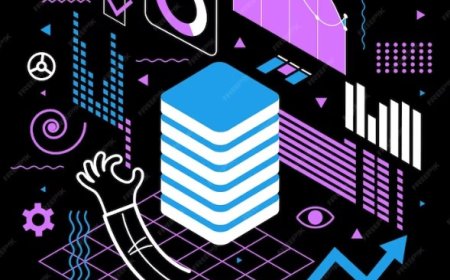The Real-World Applications of Artificial Intelligence in Data Science
Explore real-world applications of artificial intelligence in data science. Discover how AI is transforming data analysis and decision-making in various industries.

In the ever-evolving landscape of technology, the synergy between Artificial Intelligence (AI) and Data Science has emerged as a powerful force, revolutionizing industries and unlocking unprecedented insights. AI in Data Science is not merely a futuristic concept but a present-day reality, with tangible applications across various domains.
Predictive Analytics
Predictive analytics is a powerful subset of data science that focuses on harnessing historical data, statistical algorithms, and machine learning techniques to identify the likelihood of future outcomes. It goes beyond traditional business intelligence by providing organizations with the capability to anticipate trends, behaviors, and events. At its core, predictive analytics transforms raw data into valuable insights, enabling informed decision-making and strategic planning.
The process begins with the collection and preprocessing of relevant data, often involving large datasets from diverse sources. Historical patterns and relationships within this data are then identified and used to build predictive models. These models are trained to recognize patterns and correlations, allowing them to make accurate predictions when exposed to new, unseen data.
One of the primary applications of predictive analytics lies in business and finance. Organizations use it for demand forecasting, risk management, and customer relationship management. For example, retail companies can anticipate consumer preferences and optimize inventory accordingly, reducing excess stock and minimizing losses. In the financial sector, predictive analytics helps identify potential risks, detect fraud, and make data-driven investment decisions.
In healthcare, predictive analytics is transforming patient care. By analyzing historical patient data, healthcare providers can predict disease outbreaks, identify high-risk patients, and personalize treatment plans. This proactive approach not only improves patient outcomes but also enhances the efficiency of healthcare delivery.
Healthcare Diagnostics
Healthcare diagnostics is one of the most critical domains where the marriage of Artificial Intelligence (AI) and Data Science has brought about transformative changes. Traditionally, medical diagnosis has heavily relied on the expertise of healthcare professionals, often subject to human error and limited by the availability of specialized expertise. However, with the advent of AI in healthcare diagnostics, a new era of precision and accuracy has emerged.
At its core, AI-powered healthcare diagnostics leverages machine learning algorithms to analyze vast volumes of medical data, ranging from patient records and laboratory results to medical images such as X-rays, CT scans, and MRIs. These algorithms excel in pattern recognition, allowing them to identify subtle anomalies or deviations from the norm that might go unnoticed by the human eye. This capability has led to significant advancements in early disease detection and diagnosis.
One of the most prominent applications of AI in healthcare diagnostics is in medical imaging interpretation. Radiologists and pathologists can now collaborate with AI models to enhance their diagnostic accuracy. AI algorithms can highlight potential areas of concern in medical images, helping healthcare professionals make more informed decisions. For instance, in the detection of cancer, AI can assist in identifying suspicious lesions or tumors, ultimately leading to earlier intervention and improved patient outcomes.
Natural Language Processing (NLP)
-
NLP is a branch of artificial intelligence (AI) focused on enabling machines to understand, interpret, and generate human language.
-
It encompasses a wide range of tasks, including text analysis, language translation, sentiment analysis, chatbots, and more.
-
NLP technologies leverage machine learning algorithms and deep learning models to process and analyze large volumes of textual data.
-
Sentiment analysis is a common NLP application that determines the emotional tone of a piece of text, which is valuable for businesses to gauge customer feedback and market sentiment.
-
Chatbots and virtual assistants, like Siri and Alexa, utilize NLP to engage in natural, human-like conversations and perform tasks such as answering questions or setting reminders.
-
Language translation is another vital NLP application, enabling the automatic translation of text from one language to another, making global communication more accessible.
-
Named Entity Recognition (NER) is an NLP technique used to identify and classify entities such as names of people, places, organizations, and more within text.
-
Text summarization is an NLP application that condenses long texts or articles into shorter versions while preserving the main ideas and key information.
Recommendation Systems
In the era of information overload, Recommendation Systems have become indispensable in helping users navigate through the vast sea of content available online. At their core, these systems are driven by sophisticated algorithms, often employing Artificial Intelligence and machine learning techniques. Their primary goal is to analyze user behavior, preferences, and historical interactions with a platform to deliver personalized suggestions.
One of the most prominent applications of recommendation systems is in the realm of e-commerce, where they influence purchasing decisions by presenting users with products tailored to their tastes. By leveraging collaborative filtering and content-based filtering methods, recommendation systems can decipher intricate patterns within user data, drawing connections between individuals with similar preferences and suggesting items based on those associations.
In the entertainment industry, streaming services rely heavily on recommendation systems to enhance user engagement. These systems consider factors such as watch history, genre preferences, and even user ratings to curate a bespoke content catalog. This not only keeps users on the platform for longer periods but also introduces them to new content they might not have discovered otherwise.
Social media platforms also harness the power of recommendation systems to keep users engaged by suggesting friends to connect with or content to interact with based on past interactions and interests. These systems continuously learn and adapt, refining their suggestions over time as user preferences evolve.
Fraud Detection in Finance
Artificial Intelligence (AI) is revolutionizing the field of Data Science by providing advanced tools and techniques to extract meaningful insights from vast datasets. Predictive analytics, a key application, uses AI algorithms to forecast future trends based on historical data, aiding industries like finance in making informed decisions. In healthcare, AI enhances diagnostics through machine learning models that analyze medical images, improving disease detection and patient outcomes.
Natural Language Processing (NLP) empowers data scientists to understand and derive insights from unstructured data, impacting areas such as sentiment analysis and customer service chatbots. Recommendation systems, driven by AI, personalize user experiences on platforms like e-commerce and streaming services. Moreover, AI plays a pivotal role in fraud detection in finance, supply chain optimization, the development of autonomous vehicles, and energy management. These real-world applications showcase the transformative power of AI in augmenting the capabilities of Data Science across diverse sectors, promising efficiency, accuracy, and innovation.
Supply Chain Optimization
Supply Chain Optimization refers to the strategic management of the end-to-end processes involved in the production and distribution of goods or services. It involves the use of advanced technologies, data analytics, and artificial intelligence to enhance efficiency, reduce costs, and improve overall performance within the supply chain. By leveraging predictive analytics, machine learning algorithms, and real-time data, organizations can make informed decisions about inventory levels, demand forecasting, and logistics.
This optimization process aims to streamline operations, minimize delays, and respond effectively to changes in demand, ultimately ensuring that products reach their destination in the most cost-effective and timely manner. In essence, supply chain optimization is about achieving a delicate balance between supply and demand, utilizing technology to synchronize various components of the supply chain for maximum efficiency and responsiveness.
Energy Management
Energy management refers to the process of monitoring, controlling, and optimizing the use of energy in various systems and sectors to achieve efficiency, sustainability, and cost-effectiveness. In the context of artificial intelligence (AI) and data science, energy management involves leveraging advanced technologies to analyze large datasets, make intelligent decisions, and improve the overall performance of energy-related processes. Here are some key aspects of energy management and how AI in data science plays a crucial role:
Data Collection and Monitoring
-
Energy management starts with the collection of extensive data related to energy consumption, production, and distribution.
-
AI-powered sensors, smart meters, and other monitoring devices collect real-time data, providing a comprehensive view of energy usage patterns.
Predictive Analytics
-
AI algorithms analyze historical and real-time data to predict future energy demand and consumption patterns.
-
Predictive analytics helps in optimizing energy production and distribution, ensuring that the right amount of energy is generated and supplied to meet demand without excess or shortage.
Load Forecasting
-
AI models can forecast peak energy demand periods based on historical data, weather conditions, and other relevant factors.
-
This helps utility companies and businesses plan for high-demand periods, preventing grid failures and optimizing resource allocation.
Demand Response
-
AI enables demand response programs, where energy consumption is adjusted in real-time based on demand fluctuations.
-
Smart systems can automatically adjust the operation of appliances, HVAC systems, and other energy-consuming devices to balance supply and demand.
The fusion of Artificial Intelligence and Data Science is transforming industries and unlocking the true potential of data. From predictive analytics and healthcare diagnostics to recommendation systems and autonomous vehicles, the real-world applications are diverse and impactful. As we continue to embrace these technologies, it's essential to recognize the ethical considerations and ensure responsible AI deployment. The journey of AI in Data Science is an ongoing adventure, promising exciting developments that will shape the future of how we analyze, interpret, and leverage data for the betterment of society.






























































